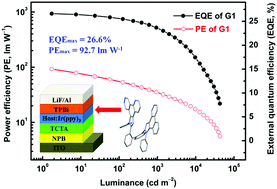A twisted phenanthroimidazole based molecule with high triplet energy as a host material for high efficiency phosphorescent OLEDs†
Abstract
For host materials, a high triplet energy level and bipolar charge transport ability are crucial properties to achieve high performance phosphorescent organic light-emitting devices (OLEDs). A unique host material, 2,2′-bis(1-phenyl-1H-phenanthro[9,10-d]imidazol-2-yl)biphenyl (BP-DPPI), was designed and synthesized by introducing two phenanthroimidazole groups onto the lateral o,o′-positions of a biphenyl skeleton. The highly twisted molecular conformation endows the compound with excellent thermal stability with a glass transition temperature of 170 °C and a high triplet energy of 2.72 eV. In addition, BP-DPPI exhibits bipolar carrier transport ability for holes and electrons. The green phosphorescent OLED with BP-DPPI as a host material exhibited a maximum external quantum efficiency (EQE) of 26.6% and a power efficiency (PE) of 92.7 lm W−1. More importantly, the device shows low efficiency roll-off, retaining a high EQE value of 23.6% at the routinely practical luminance of 1000 cd m−2.



 Please wait while we load your content...
Please wait while we load your content...